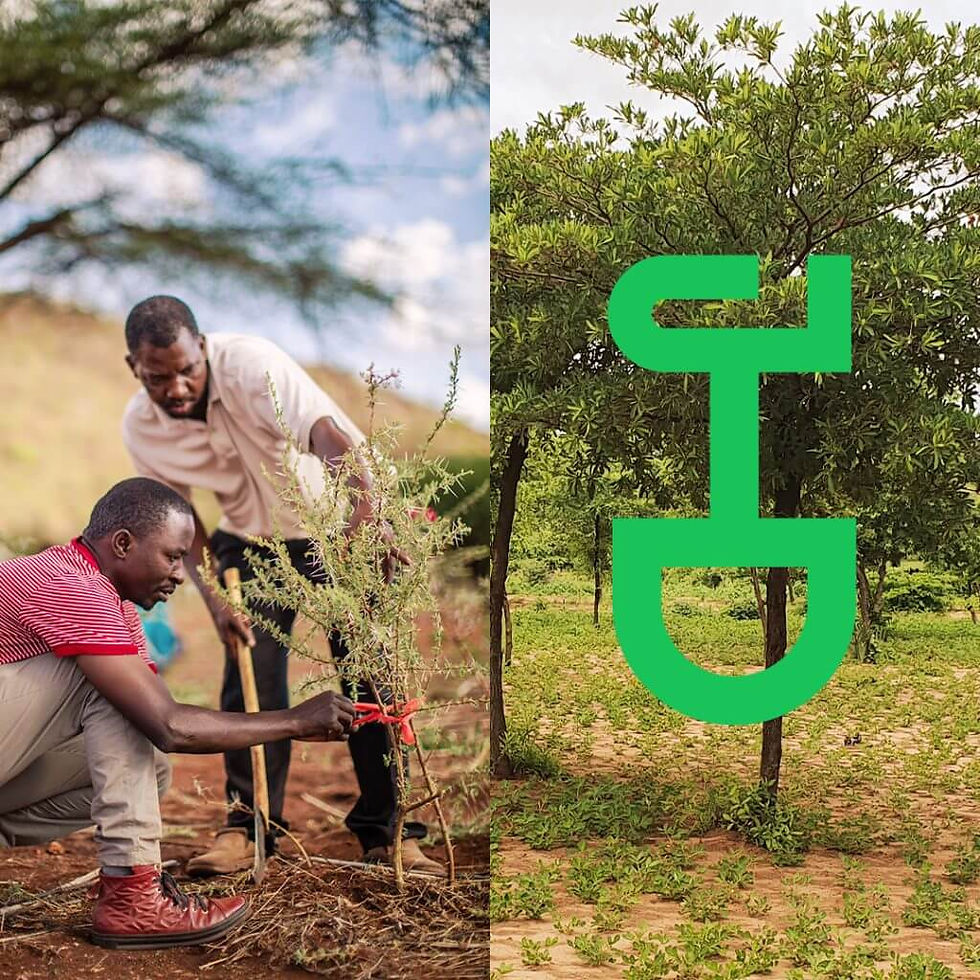How NGO JustDiggit regreening Africa and it works.
- Karine Edowiza
- 13 oct. 2022
- 6 min de lecture

The global climate crisis, warming the planet fast, is real. Earth is drying up. NGO «Justdiggit » spread a solution including farmers, pastorals and communities in
several countries to regreen Africa, but not only, and it's working. They used several
techniques as treecovery, bunds, grass seed banks, and others. They can today say
that the risk of famine is reduced, life in rural areas is better and biodiversity exists.
Let's meet the team « Justdiggit » who work in respect of Mother Nature to succeed
regreening our sick planet.
1. Who created « Justdiggit » and why in Africa first? Is the African continent a
key to fight against the climate crisis?
Justdiggit is a Dutch NGO founded in 2010 by (ao) Dennis Karpes and Peter Westerveld, based in Amsterdam and Nairobi and working on ecosystem restoration in Africa for over 10 years.
But why Africa? Well drying and degradation of land is a global problem. Especially in
vulnerable dry areas, it can have serious consequences. Regions in Africa, the Middle-East,
North-America and South-Asia are under great pressures (source: Exploring future changes
biodiversity). The population in these areas is growing faster in comparison with other areas,
making available land and water scares. Since we think it is important to make the impact of
our projects as big as possible, our projects are located in one of these most degraded
areas: Africa. Every area is different and thus need a specific method of regreening. This is
why Justdiggit chose to specialize in regreening ecosystems within Africa. In this way, we are
remaining our focus and we can make sure the best regreening techniques are used.
Since 65% of the land in Africa is affected by degradation,it leaves a lot of space for
regreening. The urgency of regreening in Africa is high. Drought and degradation of the land
cause crops failure, causing hunger and poverty within these areas. Besides this, the
regreening in Africa not only has a positive impact on nature, also the local communities and
animals are positively influenced. Do you want to know how? Take a look at our what we do page!
We know it is necessary to keep the global temperature increase below 2°C, to stop
irreversible damage to the planet that sustains us. We believe in the power of nature and in
cooling down the planet together by regreening degraded land and bringing back vegetation.
Our mission is to regreen Africa in the coming 10 years, together with all 350 million farmers.
2. Justdiggit works with communities in Africa in Kenya, Tanzania, Uganda,
Madagascar, Togo and Ethiopia, how does it work to begin work with you?
We originally started in Kenya and later expanded to Tanzania. This is where we implement
our regreening techniques and are managing a lot of projects.
In Uganda, Madagascar, Togo and Ethiopia we were asked to help and were given funding
to improve and support already existing project with communication purposes.
Communication is an essential part to upscale regreening, which is why we focus on this in
these countries. With our approach, we found a way to inspire and activate lots of people.
Since we are currently active in East Africa, we are also looking to starting projects in West
Africa.
3. Before beginning the regreening process, how can we know if soils were
ancient fertile soils or might be fertile? And how many years is the deadline to
be sure to regreen? Just the next season?
Before we start regreening, we examine the soil, the amount of rainfall, the amount of seeds
in the soil, and whether the area is located on a slope or not. The traditional regreening
techniques we apply in our project areas have been used for centuries. So we did not invent
them ourselves. However, to increase the impact of our landscape restoration activities, we
apply new technologies and science.
Bunds can make sure regreening happens in a couple of months (once the rain has fallen).
The most tricky part comes then, since it is very important to make sure that overgrazing
doesn’t happen. So to make sure the bunds have a sustainable effect, it needs to be
maintained for a couple of years. With trees, it can take up to 2 or 3 years before it’s a
(semi) mature tree.
4. You work with communities, farmers and pastoralists with the Kisiki Hai
traditional method, how does it bring healthier soil and permit the growing of
better crops?
Farmer Managed Natural Regeneration (FMNR), or Kisiki Hai (‘living stump’ in Swahili), is an
agroforestry approach to regrow trees and support new, naturally emerging sprouts to grow
bigger. Kisiki Hai involves a process of selecting, pruning and protecting stumps of cut-down
trees. With the right care, these stumps get the chance to grow into real trees again. We like
to call this method ‘Treecovery’.
Kisiki Hai brings healthier soil through the tree roots. Tree roots hold water better and
because there is more water in the soil, crops can grow better. Once trees have grown there
is more shadow. This helps against the evaporation of water (which normally happens
without shadow). The combination of water harvesting from the tree roots and the shadow
results in less erosion and less floods.
5. Let's speak about the rainwater, can it be a friend or a new enemy? First, how
do the technical bunds work? You succeed in regulating rainwater to have a
more successful regreening and fields? Secondly, do you work with new
methods of stockage of the rainwater?
Rainwater is definitely our friend. We use rainwater harvesting techniques which prevent
rainwater from running off. Instead, the water is collected and stored, so it can be used by
vegetation, animals or people. By digging bunds, for example. Learn more about rainwater
harvesting via: https://justdiggit.org/rainwater-harvesting/
To capture rainwater in the project areas in Tanzania and Kenya, Justdiggit uses a soil
management strategy by which semi-circular water bunds are dug. These bunds are able to
capture rainwater, reducing the runoff of the water. This prevents the erosion of the fertile
upper layer of the soil. Additionally, by capturing the rainwater, it has more time to infiltrate
into the soil, increasing the water availability within the ground. This enables the seeds still
present in the soil to grow, causing greening!
Only if the rainwater does not infiltrated into the soil, rainwater will cause erosion and floods
which then makes it the enemy.
6. The regreening process brings: food security, fuel, income, biodiversity,
carbon credits, cooler climate, self sufficiency, sustainability. Can you have
some successful examples and little stories about that?
In total we have already dug over 200.000 bunds, which means we regreened more than
300.000 hectares of dry, degraded land. With Kisiki Hai we recovered 9.7 million trees in
only 4 years and with our global communication campaigns we reached 291 million people
which is insane to think about! To have an insight on our work and the impact we make, you
page!
7. Do the cost of the material needed is expensive or even as an individual or
small community, you invent a kit to begin regreening a place? Is it necessary
to have a community project and live in Africa (the example of Australia)? What
are the criteria?
Our regreening projects are low budget and cost-efficient. That’s because we dig the bunds
with a shovel! There are two reasons why we dig by hand and not by machine. First, by
letting the local communities dig themselves, we give them ownership of the project, making
them more committed to the project. Because they are regreening their land, the project is
sustainable and, therefore, good for the long term. Recently, we created a platform called
Greener.land. With this tool, we encourage farmers all over the world to regreen themselves.
This tool is easy to use and helps farmers (and other individuals) to choose the right
regreening techniques, depending on the specific landscape and climate. Simple videos and
photos show how farmers can apply these regreening techniques. Are you dealing with a dry
piece of land with deep pits or maybe a wet piece of land with some stones here and there?
This tool will tell them which technique to use to regreen their land!
We think it is important to keep tools like these open source so more people can participate
in projects themselves. We as Justdiggit have our focus on Africa, but we invite the whole
world to join us in other parts of the world.
8. Regreening also means finding a new biotope? Do you have examples of
insects or animals now living in those new spaces?
We measure our impact on regreening land, bringing back trees, conserving water,
improving livelihoods and carbon sequestration. This means we do not measure the impact
on biodiversity (yet). We do know that by restoring land, different plant and animals are
returning. The people working, including rangers and communities, on the project areas are
seeing the return of wildlife!
9. How can we help you to participate in your project as an individual and as a
community?
We do not offer volunteer jobs on site as our projects are carried out by the local
communities to consolidate commitment to give them ownership over the projects. We pay
them for the work they do, which results in socio-economic advantages. However, there are
many ways in which people can participate. We have a big focus on communication, so
spreading the message is very important! So with your help of publishing this story, you give
us exposure and a platform to tell our story and reach a wider audience. That really means a
lot to us!
Other ways can be through Stream to Regreen where you simply listen to Too Much To Ask
by Don Diablo and the majority of the proceeds from the track go to Justdiggit. With every 25
streams you allow us to regreen 1M2 of degraded land!
As a community, it is possible to start your own Bundraiser. This is a new platform where you
can create a page for your fundraiser. On this page, people can set a goal to collect X
number of bunds and thus green X number of square meters in Africa. There is also the
Greener.Land platform we talked about before. Other participation options are to be found on
our Dig In page.
So, just diggit !




















Commentaires